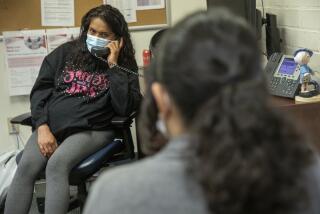Counties Ask State to Be Last-Ditch Provider for Poor
- Share via
SACRAMENTO — Fearing a growing welfare caseload, county governments asked Thursday to be relieved of the responsibility for caring for California’s poorest citizens and urged the state to take over as provider of last resort for the needy.
At a Capitol news conference, the California State Assn. of Counties appealed to state officials reviewing how to implement recently approved federal welfare reforms “to assume full responsibility” for general assistance for the poor.
“County officials fear the new welfare legislation will result in such significant increases in their general assistance costs that other vital county functions, including operation of court systems, jails and other public health and welfare services, will be sacrificed,” said Mike Nevin, a San Mateo County supervisor who is president of the association.
For more than 30 years, the state’s 58 counties have had the responsibility for general assistance to the poor. As of May, general relief was paid out to nearly 156,000 Californians. Payments averaged $225 a month, a $6 drop from the previous year, according to state figures. California counties must shoulder the entire cost--about $460 million annually--of the general relief programs.
County supervisors joined a growing chorus of politicians urging Gov. Pete Wilson to call a special legislative session to deal with the wide-ranging impacts of the federal legislation, which would eliminate a 61-year federal commitment to provide cash assistance to America’s neediest citizens.
The Wilson administration is still grappling with the effects of the federal legislation, which President Clinton has said he will sign. “It’s too soon in the process to be affirming or denying any proposal,” said Lisa Kalustian, a spokeswoman for the state Health and Welfare Agency.
Meantime, a nonprofit health policy group warned that “the cuts in the welfare reform bill passed by Congress last week are just the tip of the iceberg” for California.
Bruce Lee Livingston, executive director of the Health Access Foundation, said his analysis of a federal budget blueprint approved this year by Congress shows a $51.9-billion drop in spending over the next six years in California in Medicare, Medi-Cal and state matching funds.
If the cuts outlined in the federal plan, known as a budget resolution, are put into effect, more than 8 million Californians will be affected, including the elderly and children, according to the report by the San Francisco-based foundation.
“Our analysis shows that Medicare and Medicaid cuts over the next six years will simply devastate California counties and the needy children, seniors and disabled people who depend on them for health care,” Livingston said at a Capitol news conference.
The report estimated that Los Angeles County, with 961,000 Medicare recipients, would lose $16.2 billion over the next six years; Orange County would lose $3.5 billion; San Diego County $3.7 billion, and Ventura County $1 billion.
Past cutbacks, which were smaller, have “proven devastating” for Los Angeles County’s health care providers and users, said Health Access, a group heavily supported by unions. But in the next six years, the group said, county Medi-Cal recipients and providers would lose close to $12 billion. Medi-Cal is the California version of the Medicaid program.
After being shown the report, Irene Riley, with Los Angeles County’s Health Services Department, said the Health Access figures appear to fail to take into account a slight recent drop in the Medi-Cal caseload.
Also, she said that the federal legislation provides budget targets and that the cuts may never be approved or signed by Clinton. The budget resolution is, in fact, just the first step on the federal level. So, she said, “it’s not as big a threat to our state or our community,” compared to looming welfare cuts.
In the view of Health Access’ Livingston, counties are not prepared to offset the cutbacks triggered by welfare reform. That, he said, is “why they need to ask the state to take over the general assistance program.”
As a consequence of the federal bill, state and county officials worry that thousands of legal immigrants will become ineligible for federal benefits and probably seek county general assistance relief.
Nevin said one-third of the $55 billion in anticipated federal savings results from denying aid to legal immigrants. “In California, it is local taxpayers who will bear the brunt of these shifted costs. Denying aid to legal immigrants is not welfare reform,” he said.
Joining officials from other counties at the Capitol, Los Angeles County Supervisor Mike Antonovich said he, too, wants to lift the requirement that the county pay for general relief to the poor. The state, he said, must also give counties more flexibility in welfare programs.
The county, he said, must have the “ability to attach the Mercedes and the San Marino [and] Beverly Hills homes of those sponsors who bring people here [from abroad] and leave them on our doorstep without providing” for their health and welfare.
“What the welfare lobby wants is the status quo,” Antonovich said, “which has proven to be a failure and has not provided the safety net to get people back into the mainstream.”
Casey S. McKeever, directing attorney for the Western Center on Law and Poverty, agreed that the main impact of the federal welfare legislation, at least initially, would be on legal immigrants who lose eligibility for other assistance.
In McKeever’s mind, Antonovich “seems to want to eliminate any duty altogether” to care for poor people in need.
More to Read
Get the L.A. Times Politics newsletter
Deeply reported insights into legislation, politics and policy from Sacramento, Washington and beyond. In your inbox twice per week.
You may occasionally receive promotional content from the Los Angeles Times.










